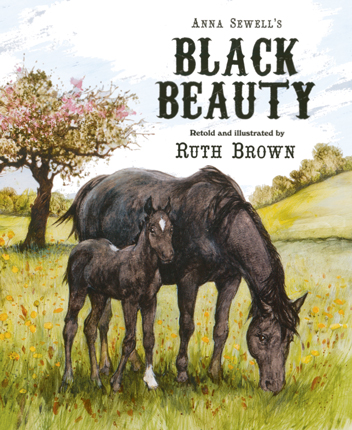Full Text Reviews: Booklist - 09/15/2016 As a colt, Black Beauty learns that trusting his instincts is more important than obedience, a lesson that serves him well during a stable fire, when he allows a groom to lead him to safety and, one stormy night, when he refuses to cross a damaged bridge. Some of his owners are kind and others cruel, but in the end he finds a good home. Narrated by a horse in Victorian England and first published in 1887 in hopes of bringing about reform in the treatment of horses, Sewell’s Black Beauty was a success by any measure. Like Sharon Lerner’s picture-book version of Black Beauty (2009), illustrated by Susan Jeffers, this version features a story pared down to the essentials and illustrations that communicate the drama and pathos in ways that are accessible to younger children. Brown, a writer/illustrator whose previous animal stories include Gracie, the Lighthouse Cat (2011) and Greyfriars Bobby (2014), draws people and horses with equal facility, grace, and expression. A satisfying picture book for young horse fans. - Copyright 2016 Booklist. School Library Journal - 10/01/2016 Gr 1–3—This retelling joins several other picture book versions. It begins with a short foreword explaining the intent and impact of Sewell's work. Brown touches on major points from the original and maintains the horse's perspective. The story starts with Black Beauty following his mother's advice and trusting his instincts to save his stablemate, Ginger, from a fire and his master from a flooded bridge. In broad strokes, Brown covers the protagonist's life as a carriage horse, cab horse, and workhorse and concludes with the animal's reunion with his favorite groom. In keeping with the original, Black Beauty's cruel treatment is evident in the text and illustrations, but Brown omits gritty details, and the harsher aspects are balanced by happier times. The traditional, watercolor-style illustrations not only do justice to the narration but enliven it as well. The use of light and dark enhances the mood, and the artist gives her human and animal characters expressive faces. An afterword offers a quick overview of Sewell's life. VERDICT A good introduction to a classic, perfect for classroom reading and storytimes with older children. Pair it with Peter Parnall's Stuffer and Mônica Carnesi's Little Dog Lost for animal tales with happy endings.—Catherine Callegari, formerly at Gay-Kimball Library, Troy, NH - Copyright 2016 Publishers Weekly, Library Journal and/or School Library Journal used with permission. Loading...
|



